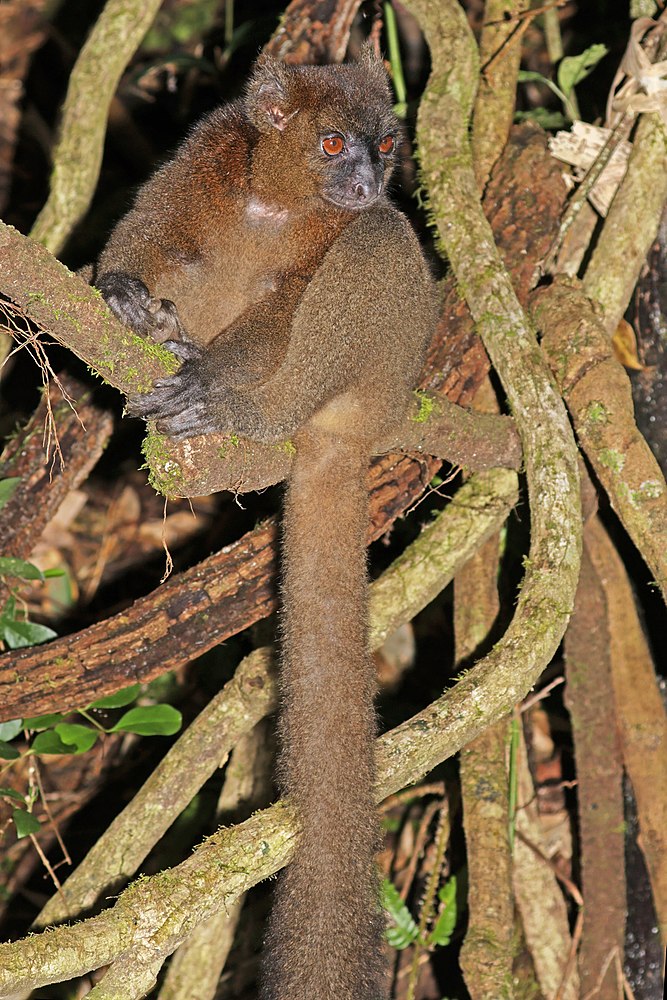What is the maximal age a Greater bamboo lemur reaches?
An adult Greater bamboo lemur (Hapalemur simus) usually gets as old as 12 years.
Greater bamboo lemurs are around 139 days in the womb of their mother. When born, they weight 45 grams (0.1 lbs) and measure 15.7 cm (0′ 7″). As a member of the Lemuridae family (genus: Hapalemur), a Greater bamboo lemur caries out around 1 little ones per pregnancy, which happens around 1 times a year. Fully grown, they reach a bodylength of 37 cm (1′ 3″).
As a reference: Usually, humans get as old as 100 years, with the average being around 75 years. After being carried in the belly of their mother for 280 days (40 weeks), they grow to an average size of 1.65m (5′ 5″) and weight in at 62 kg (137 lbs), which is obviously highly individual.

The greater bamboo lemur (Prolemur simus), also known as the broad-nosed bamboo lemur and the broad-nosed gentle lemur, is the largest bamboo lemur, at over five pounds or nearly 2.5 kilograms. It has greyish brown fur and white ear tufts, and has a head-body length of around one and a half feet, or forty to fifty centimeters. They have relatively long tails and long back legs for leaping vertically amongst the trees of their forest habitat. It feeds almost exclusively on the bamboo species of Cathariostachys madagascariensis, preferring the shoots but also eating the pith and leaves. It is unknown how their metabolism deals with the cyanide found in the shoots. The typical daily dose would be enough to kill humans. Greater bamboo lemurs occasionally consume fungi, flowers, and fruit. Its main food source is bamboo and it is the main reason why it has become critically endangered. Areas with high density of bamboo have major human disturbances, where humans cut or illegally cut down bamboo.Its only confirmed predators are the fossa and the bushpigs, but raptors are also suspected. Its current range is restricted to southeastern Madagascar, although fossils indicate its former range extended across bigger areas of the island, including as far north as Ankarana. Some notable parts of the current range are the Ranomafana and Andringitra National Parks.Greater bamboo lemurs live in groups of up to 28. Individuals are extremely gregarious. The species may be the only lemur in which the male is dominant, although this is not certain. Because of their social nature, greater bamboo lemurs have at least seven different calls. Males have been observed taking bamboo pith away from females that had put significant effort into opening the bamboo stems. In captivity, greater bamboo lemurs have lived over the age of 17.
Animals of the same family as a Greater bamboo lemur
Not really brothers and sisters, but from the same biological family (Lemuridae):
- Gray-headed lemur growing to a mass of 2.4 kgs (5.29 lbs)
- Eastern lesser bamboo lemur becoming 17.08 years old
- Ring-tailed lemur becoming 30 years old
- Common brown lemur becoming 37 years old
- Red ruffed lemur growing to a mass of 3.87 kgs (8.53 lbs)
- Greater bamboo lemur becoming 12 years old
- Crowned lemur becoming 9.17 years old
- Red-bellied lemur with 1 babies per pregnancy
- Sanford’s brown lemur growing to a mass of 2.39 kgs (5.27 lbs)
- Golden bamboo lemur with 1 babies per pregnancy
Animals that reach the same age as Greater bamboo lemur
With an average age of 12 years, Greater bamboo lemur are in good companionship of the following animals:
- Mountain nyala usually reaching 11 years
- Hispaniolan hutia usually reaching 9.83 years
- Silver-haired bat usually reaching 12 years
- Groundhog usually reaching 10 years
- Leadbeater’s possum usually reaching 11 years
- Parma wallaby usually reaching 10 years
- Calabar angwantibo usually reaching 13 years
- Striped skunk usually reaching 12.92 years
- Zebra duiker usually reaching 12.17 years
- Greater false vampire bat usually reaching 14 years
Animals with the same number of babies Greater bamboo lemur
The same number of babies at once (1) are born by:
- Northern brushtail possum
- Common vampire bat
- Tricolored bat
- Hoolock gibbon
- Japanese macaque
- Hooded seal
- Black giant squirrel
- Formosan rock macaque
- Brown woolly monkey
- Townsend’s mole
Weighting as much as Greater bamboo lemur
A fully grown Greater bamboo lemur reaches around 2.04 kg (4.5 lbs). So do these animals:
- Hoary marmot weighting 2.25 kilos (4.96 lbs) on average
- White-faced saki weighting 1.67 kilos (3.68 lbs) on average
- Mexican hairy dwarf porcupine weighting 2 kilos (4.41 lbs) on average
- Granada hare weighting 2.33 kilos (5.14 lbs) on average
- Silky cuscus weighting 2 kilos (4.41 lbs) on average
- Coppery ringtail possum weighting 1.77 kilos (3.9 lbs) on average
- Scaly-tailed possum weighting 1.81 kilos (3.99 lbs) on average
- Manchurian hare weighting 1.84 kilos (4.06 lbs) on average
- Rusty-spotted genet weighting 1.95 kilos (4.3 lbs) on average
- Equatorial saki weighting 2.38 kilos (5.25 lbs) on average
Animals as big as a Greater bamboo lemur
Those animals grow as big as a Greater bamboo lemur:
- Sunda flying lemur with 38 cm (1′ 3″)
- Cozumel raccoon with 42.8 cm (1′ 5″)
- Northern olingo with 41.2 cm (1′ 5″)
- Indian grey mongoose with 40 cm (1′ 4″)
- Siberian weasel with 30.6 cm (1′ 1″)
- Weyland ringtail possum with 31 cm (1′ 1″)
- Humboldt’s white-fronted capuchin with 38.4 cm (1′ 4″)
- Eastern bettong with 33.1 cm (1′ 2″)
- Cape hare with 42.6 cm (1′ 5″)
- Xerus erythropus with 31.2 cm (1′ 1″)
